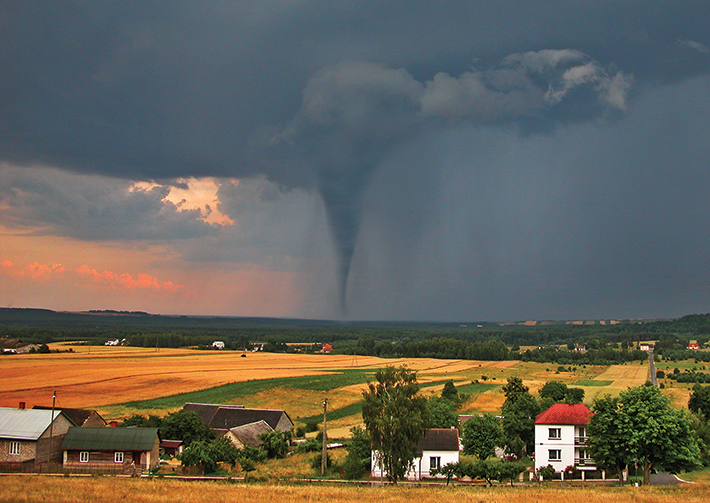
Principles of resilience are a key part of the world today. Here is how resilient systems can strengthen our response to natural disasters, fires, and more.
By Michael Schmeida
Mar 13, 2024
In 2016, I wrote an article entitled “What is Resiliency?” At the time, my thoughts focused strictly on what this term might mean in the context of a standards world where it had yet to be defined. As a term that was picking up steam, a definition was needed to shape useful conversation about the notion of resilience.
Wow, have things changed! Today, the word resilience is in widespread usage, whether in well-being or business or industry. As the world evolved and my work within ASTM was increasingly shaped by my peers, I developed a very different understanding of this term and what it meant.
LISTEN: What Can Be Done About Infrastructure? – Podcast
In 2022, ASTM International published the standard guide for general principles of resilience (E3341). Released under the auspices of the committee on sustainability (E60), the guide lays out four principles of resilience, the interdependence of these concepts, and how users can move forward in the creation of more resilient systems. Note the use of the word “more” – like sustainability, complete resilience is an ideal which can never be 100% achieved.
Most importantly, E3341 defines this term for the standardization world:
resilience, n – the ability to prepare for anticipated hazards, adapt to changing conditions, to withstand and limit negative impacts due to events, and to return to intended functions/services within a specified time after a disruptive event.
Discussion – Resilience is not durability nor sustainability but may include those concepts.
The four principles are discussed in detail in their own respective sections of the Standard. E3341 also gives a brief overview of each concept:
- Planning and Preparation: Planning and preparation involve identifying measurable system performance requirements, goals for improved resilience, relevant hazards and stressors for the system(s) under consideration, interdependencies, and engagement of relevant stakeholders who have a role or an interest in the operation or function of the system.
- Adaptation: Adaptation addresses the performance of the system for future disruptive events or stressors.
- Withstanding and Limiting Impacts: Withstanding and limiting impacts is the ability of a system to resist the loads and effects of a disruptive event or stressor such that the system remains able to perform with respect to its intended function. Any damage should not interfere with system functions.
- Recovery: Recovery occurs over a period of time that can be divided into stages or phases associated with resumption of services and functions, possibly with temporary measures, and repairs and construction to restore the full functional performance and physical condition of the system. Recovery may include improvements to the functional performance or condition of the system, adaptation for new or additional functions, or to address future events or stressors.
As one can see, the definition of resilience and the principles are all quite broad; in fact, E3341 is intended to be applied to anything from a car to a community. This nebulous topic needed a definition that could work for everyone. And that’s a good thing. ASTM now has many standards published or in development that deal with the concept of resilience. These deal with systems of all sizes, including communities. Regardless of the area, they now can be discussed in a standardized manner.
Why Resilience Matters
It is one thing to define a term and a totally different thing to apply it and understand the value of the concept for the world. There is much discussion about resilience today, not only in the standards world but especially in the context of the built environment. Natural disasters are becoming more common on scales not often seen by humans. Per the National Oceanic and Atmospheric Administration (NOAA), in 2023 in the U.S. alone, 28 separate weather or weather-related events alone cost at least one billion dollars in losses, adding up to approximately $93 billion in losses. The same report also notes the loss of 492 lives.
READ MORE: Sustainability and Standardization – Interview
Applying the principles of resilience results in systems that can better handle stressors. For example, the threat wildfires pose to structures. If the structure lies within the wildland-urban interface, as governed by regulation such as by the International Wildland-Urban Interface Code (IWUIC), resilience may be a “requirement.” But even in areas where it is not, resilience should be considered.
In planning and preparation, the proximity of a structure to the wildland-urban interface and the potential for wildfire in that area is an important consideration. Identifying wildfire as a meaningful possibility will dictate numerous aspects of planning and preparation, including placement of the structure on the land, entrance and egress from the property to adjacent roads, and access to water.
Designing with resilience in mind demands that the structure be adapted to reflect the potential for wildfire. All design and structural decisions must be guided by the need to adapt the structure to an environment where fire is a potential disruptive event. In practical terms, to limit the impact of fire, resistant exterior wall assemblies must be selected to minimize the potential for fire spread; trees must be cleared from the perimeter of the building for the same reason; and entrance and egress must be considered with both evacuation and fire-service access in mind, among many other design actions. Especially in cases where life safety is paramount, mitigation of potential fire impacts is of utmost importance. It is not always possible to create a system that entirely avoids dangerous scenarios; however, resilience is an ideal guide to decision making. It can never be perfectly realized.
Because 100% resilience is not attainable, a recovery phase is inherent to the concept. In the event of a fire some impacts may be impossible to avoid entirely. Regarding withstanding and limiting impact, can the fire occur, and the structure still be functional? With planning and adaptation, can occupants return and begin repairs more quickly? If the structure is a dwelling, can it provide basic shelter and protect occupants from the need to resort to alternative housing? Is there less to repair or restore than there would have been if resilience had not been a factor in the planning and design? Finally, if the structure was lost to fire, did the consideration given to items such as the perimeter of the site, to the landscape and roads allow for escape? Here, the need for adaptation reoccurs. During recovery, the post-event structure must take into consideration lessons learned from the catastrophic event in order to be more resilient against potential future events.
FOR YOU: A Road Map to ESG
In the above example, note the overlap and reoccurrence of the four principles. For example, withstanding and limiting impacts leads to a potentially quicker recovery. Another example is the opportunity for a positive feedback loop. Resilience is only achieved if consideration is given to past experience. The ideal, resilience, must change in response to greater understanding of the threat. It is possible that the threat is so great that avoidance is the most resilient outcome. Again, we see how complex this concept is to understand.
Whether it be a building, a car, or a pair of shoes, application of the now well-defined concept of resilience could save resources, money, and time – potentially even lives. ∎
Michael Schmeida is director of codes, standards and research, for the Gypsum Association. He oversees and coordinates technical publications, standards, and testing efforts for the organization. Schmeida serves on many ASTM International committees, including lime and limestone (C07), gypsum and related building materials and systems (C11), roofing and waterproofing (D08), and sustainability (E60).
January / February 2008


